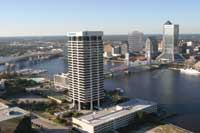Advantage: Converters Keep in mind, this high-value trend is occurring in an apartment market that has remained relatively flat over the last several years. In fourth quarter 2004, for example, a survey by CALEX Realty Group (one of northeast Florida’s largest managers of multifamily properties) noted that the average multifamily occupancy in Jacksonville was 93 percent. That compares closely to the occupancies reported in the third and fourth quarters of 2004 (93.4 percent and 92.6 percent, respectively). The survey showed average rents equally flat, at $731 (or 78 cents per square foot) per month in third quarter 2004 versus $733 (or 79 cents per square foot) per month in fourth quarter 2004.
Such high buyer interest and values in such a flat market have caused cap rates in Jacksonville to fall in the past two years from a fairly soft 9 percent down to mid-6 percents today.
These trends are not only distorting the true value of Jacksonville multifamily properties but are also making it virtually impossible for the authentic apartment buyer to make the numbers work for an own/rent model. Converters get to the deal first and offer more than the authentic apartment buyer ever could.
Clearly, if you’re a Jacksonville apartment owner ready to sell, this means there’s no better time than the present. Buyers are coming to the market from across the nation, and the sellers can push their sale price to the maximum.
On the buy side, those interested in conversion may still have some time left in Jacksonville, although many Florida economists are concerned about the level of the market’s condominium conversion and construction activity. They have seen the results of condo overbuilding in the market in the late 1970s and again in the late 1980s and are paying attention. “Florida condominiums are overbuilt about every 10 years. You can almost set your watch by it, but you can’t necessarily relate this environment to overbuilding eras of the past,” says Joel Coykendall, senior vice president for NorthMarq Capital in Jacksonville, a national real estate investment firm producing more than $9 billion in originations annually. “This time around, rates are a lot lower, condominium buyers have inexpensive investment capital at their fingertips, and a great many are baby boomers who have accumulated and inherited wealth are looking for second homes.” Coykendall says there are “a lot of demographic changes occurring that add stability to this condo boom” but warns that there are concerns with regard to the number of buyers who are speculators or investors as opposed to actual buyers.
